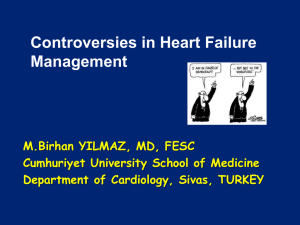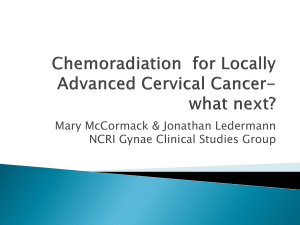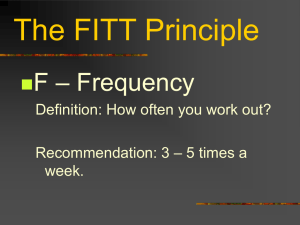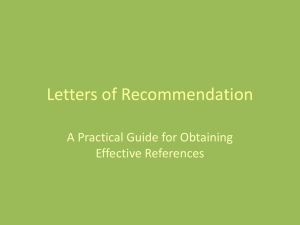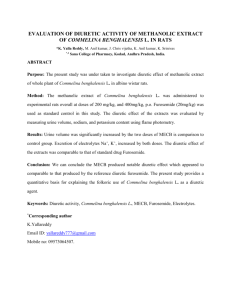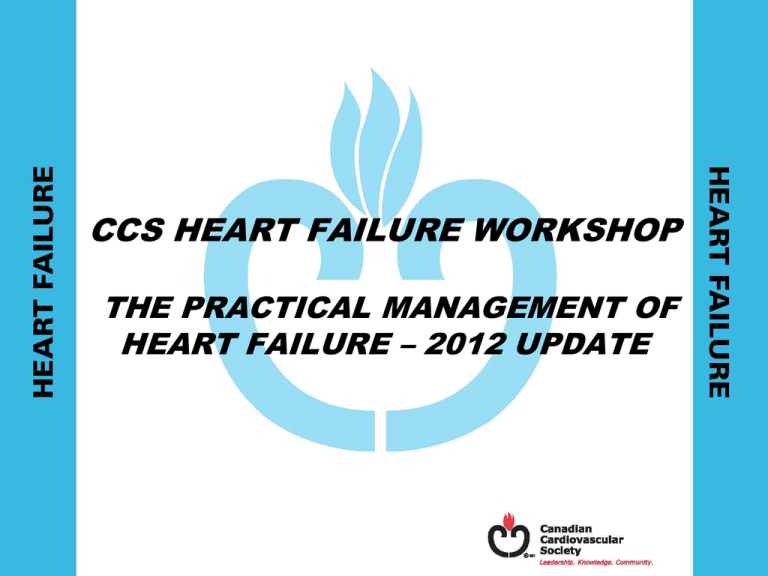
CCS HEART FAILURE WORKSHOP
THE PRACTICAL MANAGEMENT OF
HEART FAILURE – 2012 UPDATE
WELCOME!
Learning Objectives
At the conclusion of this workshop, participants will be
able to:
1. Review changes and updates for optimal
management of chronic and acute heart failure;
updating 2006 recommendations to 2012 context and
environment;
2. Discuss exercise for heart failure patients - where to
begin, what to do and where to end; and
3. Identify opportunities and challenges of surgery for
patients with an ischemic etiology for heart failure.
Heart Failure Guidelines
Acute Heart Failure
What is heart failure?
• Chronic Heart Failure (CHF):
– Heart failure is a complex syndrome in which
abnormal heart function results in, or increases
the subsequent risk of, clinical symptoms and
signs of low cardiac output and/or pulmonary or
systemic congestion.
• Acute Heart Failure Syndrome (AHF):
– “gradual or rapid change in heart failure signs
and symptoms resulting in the need for urgent
therapy”
Heart Failure Guidelines
Classification of AHF
usually a hx of prog.
worsening of known chronic HF on Rx,
and evidence of systemic/pulmonary
congestion.
high BP, +/- preserved LV systolic fxn;
increased sympathetic tone with ↑HR,
vasoconstriction; may be euvolaemic
or only mildly hypervolemic, and
frequently with signs of pulmonary or
systemic congestion
Severe respiratory distress, ↑RR,
orthopnea, rales. O2 sats <90% RA
prior to O2
Clinical and lab evidence of an
ACS; ~15% of patients with an
ACS have signs and symptoms
of HF. Episodes of AHF are
frequently assoc w/ or
precipitated by arrhythmia
(bradycardia, AF, VT).
Usually sys BP <90 mmHg or
drop in MAP >30 mmHg and
absent/low urine output. Organ
hypoperfusion and pulmonary
congestion develop rapidly
Heart Failure Guidelines
low output in absence of
pulmonary congestion with
increased JVP, w/ or w/out
HSM, and low LV filling
pressures
ESC 2008
Has care evolved?
1950
Morphine
1974
2012
Morphine
Morphine?
Oxygen
Oxygen?
Dietary sodium restriction
Dietary sodium restriction?
Sedation
Dietary sodium restriction
Strict bed rest
Early mobilization
Digitalis
Inotropes
Avoid inotropes
Mercurial diuretics
Diuretics
?Diuretics
Venesection
Vasodilators
?Vasodilators
Harrison’s Principles of Internal Medicine 1st Edition (1950)
Ramirez A et al. N Engl J Med 1974;290(9):499-501
Heart Failure Guidelines
CASE 1
• 74 year old female
• 2 months worsening SOB/orthopnea
• Presented to ED after Chinese food
• Past Hx unclear, no meds
• Physical exam
• HR 98, BP 142/82, RR 28, temp 36.0C
• JVP elevated, crackles, pulses 2+,
legs warm and LEE+
Heart Failure Guidelines
CASE 1
• 74 year old female
• CXR = pending
• Labs = pending
Heart Failure Guidelines
…
prepare to provide your answer!
Heart Failure Guidelines
How confident are you that it is
AHF?
1.
2.
3.
4.
5.
<20%
21-40%
41-60%
61-80%
>80%
Heart Failure Guidelines
How confident are you that it is
AHF?
1.
2.
3.
4.
5.
<20%
21-40%
41-60%
61-80%
>80%
No right answer
Heart Failure Guidelines
AHF Dx Scoring systems
Predictor
Elevated NT-proBNP
Interstitial edema on
CXR
Orthopnea
Absence of fever
Current loop diuretic
use
Age > 75 years
Rales on lung
examination
Absence of cough
Interpretation
Points
4
Our Case
?
2
?
2
2
2
1
-
1
-
1
1
1
1
4
e.g. At a score of 9, PPV 92%, NPV 82%, sens 70, spec 93
Baggish AL, et al. Am Heart J 2006; 151: 48-54].
Heart Failure Guidelines
CASE 1
• 74 year old female
• CXR = increased pulmonary markings c/w
edema, no evidence of COPD
• Labs = troponin I 0.20
– BNP 728 pg/ml
– Creatinine 130
Heart Failure Guidelines
AHF Dx Scoring systems
Predictor
Elevated NT-proBNP
Interstitial edema on
CXR
Orthopnea
Absence of fever
Current loop diuretic
use
Age > 75 years
Rales on lung
examination
Absence of cough
Interpretation
Points
4
Our Case
4
2
2
2
2
2
1
-
1
-
1
1
1
1
10
e.g. At a score of 9, PPV 92%, NPV 82%, sens 70, spec 93
Baggish AL, et al. Am Heart J 2006; 151: 48-54].
Heart Failure Guidelines
CCS 2012
We recommend the use of a validated diagnostic
scoring system for patients in whom the
diagnosis of AHF is being considered (Strong
Recommendation, Moderate Quality
Evidence).
e.g. PRIDE score, Boston criteria
This recommendation places a relatively high
value on evaluating the constellation of clinical
findings in a patient with suspected AHF and
less value on an individual physical
examination finding, presenting symptom or
investigation.
Heart Failure Guidelines
CCS 2012
• We recommend that in the clinical scenario when
the clinical diagnosis of AHF is of intermediate
pre-test probability, NP level be obtained to
rule-out (BNP <100 pg/ml; NT-proBNP <300
pg/ml) or rule-in (BNP >500 pg/ml; NT-proBNP
>900 pg/ml if age 50-75 years, NT-proBNP
>1800 if age >75 years) AHF as the cause for
the presenting symptoms suspicious of AHF
(Strong Recommendation, Moderate Quality
Evidence)
Heart Failure Guidelines
CCS 2012: Practical Tips
• A precipitating cause for AHF should be sought.
• An ECG and a chest x-ray should be performed
within 2 hours of initial presentation.
• Initial blood tests should include: complete blood
count, creatinine, blood urea nitrogen, glucose,
sodium, potassium, and troponin.
Heart Failure Guidelines
CCS 2012: Practical Tips
• A transthoracic echocardiogram should be
performed within 72 hours of presentation.
• For patients with a prior echocardiogram,
another is not required unless there has been
a significant change in clinical status requiring
investigation, a lack of clinical response to
appropriate therapy and/or it is greater than
12 months since the prior echocardiogram.
Heart Failure Guidelines
CASE 2
• 52 year old male with history of HF
– Presented to ED after the Edmonton Oilers won the
Stanley Cup
•
•
•
•
•
•
SOBOE, orthopnea
HR 98, BP 99/52, RR 24, temp 36.0c
JVP difficult to assess (thick neck)
crackles
pulses weak, legs cool and LEE
Trop 0.15
Heart Failure Guidelines
…
prepare to provide your answer!
Heart Failure Guidelines
Where on this table does this pt fit?
1
Dry and Warm
Increasing
Perfusion/
Cardiac Output
3
Dry and Cold
2
Wet and Warm
4
Wet and Cold
Increasing Congestion / PCWP
Adapted from Forrester, Am J Med 1978
Nohria et al. JACC 2003; 41:1797-804
Heart Failure Guidelines
Where on this table does this
pt fit?
1.
2.
3.
4.
Dry and Warm
Wet and Warm
Dry and Cold
Wet and Cold
0%
1
Heart Failure Guidelines
0%
0%
2
3
0%
4
Where on this table does this pt fit?
1
Dry and Warm
Increasing
Perfusion/
Cardiac Output
3
Dry and Cold
2
Wet and Warm
4
Wet and Cold
Increasing Congestion / PCWP
Adapted from Forrester, Am J Med 1978
Nohria et al. JACC 2003; 41:1797-804
Heart Failure Guidelines
Admit or discharge?
Heart Failure Guidelines
Heart Failure Guidelines
Treatment options?
Heart Failure Guidelines
CCS 2012: Oxygen
We recommend supplemental oxygen be considered for
patients who are hypoxemic; titrated to an oxygen
saturation >90% (Strong Recommendation, Moderate
Quality Evidence).
•
Values and Preferences: This recommendation places
relatively higher value on the physiologic studies
demonstrating potential harm with the use of excess
oxygen in normoxic patients and less value on longterm clinical usage of supplemental oxygen without
supportive data.
Heart Failure Guidelines
CCS 2012: CPAP/BIPAP
We recommend CPAP or BIPAP not be used
routinely (Strong Recommendation,
Moderate Quality Evidence).
Values and Preferences: This recommendation
places high weight on RCT data with a
demonstrated lack of efficacy and with safety
concerns in routine use. Treatment with
BIPAP/CPAP may be appropriate for patients
with persistent hypoxia and pulmonary
edema.
Heart Failure Guidelines
CASE 2
• 52 year old male with history of HF
– Presented to ED after the Edmonton Oilers won the
Stanley Cup
•
•
•
•
•
•
SOBOE, orthopnea
HR 98, BP 99/52, RR 24, temp 36.0c
JVP difficult to assess (thick neck)
crackles
pulses weak, legs cool and LEE
Trop 0.15
Heart Failure Guidelines
…
prepare to provide your answer!
Heart Failure Guidelines
How much diuretic will you give
and how?
1.
2.
3.
4.
5.
IV lasix 20 mg bid
IV lasix 40 mg bid
IV lasix 80 mg bid
IV lasix 10 mg/hour infusion
Other choice
Heart Failure Guidelines
DOSE: Study Design
Acute Heart Failure (1 symptom AND 1 sign)
<24 hours after admission
2x2 factorial randomization
Low Dose (1 x oral) Low Dose (1x oral)
Q12 IV bolus
Continuous
infusion
High Dose (2.5 x
oral)
Q12 IV bolus
High Dose (2.5 x
oral)
Continuous infusion
48 hours
1) Change to oral diuretics
2) continue current strategy
3) 50% increase in dose
e.g.
Home dose = 40 mg BID
Bolus = 80 (low) 200 (high)
72 hours
Co-primary endpoints
60 days
Clinical
endpoints
Heart
Failure
Guidelines
Felker, NEJM 2011
DOSE: Co-Primary Endpoints
• Efficacy:
– Patient Global Assessment by visual analog
scale over 72 hours using area under the curve
• Safety:
– Change in creatinine from baseline to 72 hours
Heart Failure Guidelines
DOSE: patient
global
assessment
Heart Failure Guidelines
DOSE: Death, Rehosp, ER visit
Heart Failure Guidelines
DOSE-AHF Conclusions
• There was no statistically significant
difference in global symptom relief or
change in renal function at 72 hours for
either:
• bolus vs. infusion or low vs. high
• No clinical differences…but
– High was associated with favorable trends:
–
–
–
–
Symptom relief (global assessment and dyspnea)
Weight loss and net volume loss
Proportion free from signs of congestion
Reduction in NT-proBNP
Heart Failure Guidelines
CCS 2012: Diuretics
We recommend intravenous diuretics be given as first
line therapy for patients with congestion (Strong
Recommendation, Moderate Quality Evidence).
We recommend for patients requiring intravenous
diuretic therapy, furosemide may be dosed
intermittently (e.g. twice daily) or as a continuous
infusion (Strong Recommendation, Moderate
Quality Evidence).
Heart Failure Guidelines
Diuretic dosing for ADHF
Creatinine
clearance*
≥ 60 mL/min/1.73m2
< 60 mL/min/1.73m2
Initial
IV dose†
Patient
Maintenance
dose
New-onset HF or no maintenance
diuretic therapy
Furosemide 20-40 mg
2-3 times daily
Lowest diuretic dose
that allows for
Established HF or chronic oral
diuretic therapy
Furosemide bolus equivalent
to oral dose
clinical stability is
the ideal dose
New-onset HF or no maintenance
diuretic therapy
Furosemide 20-80 mg
2-3 times daily
Established HF or chronic oral
diuretic therapy
Furosemide bolus equivalent
to oral dose
*Creatinine clearance is calculated from the Cockroft-Gault or Modified Diet in Renal Disease formula. See text for details.
† Intravenous continuous furosemide at doses of 5 to 20mg/h is also an option.
Practical Tips When Response to Diuretic is Suboptimal
• Reevaluate the need for additional diuresis by assessing volume status
• Restrict NA+/H2O intake (and exercise caution reducing oral intake below 500 ml per 24 hours).
• Review diuretic dosing. Higher bolus doses will be more effective than more frequent lower doses. Diuretic infusions (eg, furosemide 20-40 mg bolus
then 5-20 mg/h) can be a useful strategy when other options are not available.
• Add another type of diuretic with different site of action (thiazides, spironolactone). Thiazide diuretics (eg oral metolazone 2.5-5 mg OB/BID or
hydrochlorothiazide 25-50 mg) are often given at least 30 minutes before the loop diuretic to enhance diuresis, although this is not required to have
an adequate effect.
• Consider hemodynamic assessment and/or positive inotropic agents if clinical evidence of poor perfusion coexists with diuretic resistance.
• Refer for hemodialysis, ultrafiltration, or other renal replacement strategies if diuresis is impeded by renal insufficiency.
Heart Failure Guidelines
…
prepare to provide your answer!
Heart Failure Guidelines
For a persistently symptomatic
patient with HF, what is next
option?
1.
2.
3.
4.
5.
6.
Higher dose lasix
Different diuretic
Add vasodilator
Add inotropic agent
Patience….
Other choice
Heart Failure Guidelines
CCS 2012: Vasodilators
• We recommend the following intravenous vasodilators,
titrated to systolic blood pressure (SBP) > 100 mmHg, for
relief of dyspnea in hemodynamically stable patients (SBP
> 100 mmHg):
a) Nitroglycerin (Strong Recommendation, Moderate Quality
Evidence);
b) Nesiritide (Weak Recommendation, High Quality
Evidence);
c) Nitroprusside (Weak Recommendation, Low Quality
Evidence).
AHA 2012: RELAX-AHF, CARRESS
Heart Failure Guidelines
CCS 2012: Inotropes
• We recommend hemodynamically stable patients do not
routinely receive inotropes like dobutamine, dopamine or
milrinone (Strong Recommendation, High Quality
Evidence).
• Values and Preferences These recommendations for
inotropes place high value on the potential harm
demonstrated when systematically studied in clinical trials
and less value on potential short term hemodynamic effects
of inotropes.
Heart Failure Guidelines
Do I stop the beta-blockers on
admission?
• Cohorts suggest continuing beta-blockers advantageous
• RCT: B-CONVINCED
–
–
–
–
Keep vs. Stop strategy in known HF pts on beta-blockers
Keep was non-inferior to Stop.
Does not delay clinical improvement
Predicts staying on BB in the longer term
Heart Failure Guidelines
Eur Heart J 2009; 30:2186-92
RESYNCHRONIZATION THERAPY
and
DEVICES
Anique Ducharme, MD MSc FRCPC
Conflict Disclosures
The speaker has received fees/honoraria from the following
sources:
Abbott vascular, Medtronic, Merck, Otsuka, Pfizer, Sorin &
St-Jude Medical
None of the drugs, devices, or treatment modalities mentioned
in this presentation are non approved indications.
Anique Ducharme, Institut de Cardiologie de Montréal, Université de Montréal
A Case of Mild Heart Failure
• 61 years old female,
• BP 99/67 mmHg, HR 76
previous MI,
bpm
• stable NYHA II, LVEF 25% • K, 4.7 mEq/L; NT-proBNP
4500 pg/mL
• On optimal dose of
lisinopril, eplerone and • EKG: old anterior MI, LBBB
bisoprolol, occasional
QRS 155 ms.
diuretics
• Has not been assessed
for device Rx
Heart Failure Guidelines
…
prepare to provide your answer!
Heart Failure Guidelines
You started treating this patient with mild symptoms
of HF and low ejection fraction with epleronone as
recommended. Dosage was increased up to 50 mg
without side effects. What do you do next?
1.
2.
3.
4.
Angiotensin receptor blocker
ICD
CRT
CRT + ICD (CRT-D)
Heart Failure Guidelines
CRT in Patients with Mild HF Symptoms:
MADIT-CRT
1820 pts, mostly NYHA II, CRT+ICD vs ICD alone
Low risk population, annual mortality ~3%
40% reduction in HF events in CRT-ICD group
Moss et al, NEJM 2009
Heart Failure Guidelines
RAFT: Death or HF hospitalization
Outcome
ICD (N=904)
ICD-CRT
(N=894)
Hazard ratio
(95% CI)
P
value
363 (40.3%)
297 (33.2%)
0.75 (0.640.87)
<0.001
Death from any cause
236 (26.1%)
186 (20.8%)
0.75 (0.620.91)
0.003
Hospitalization for HF
236 (26.1%)
174 (19.5%)
0.68 (0.560.83)
<0.001
Primary outcome
Death or
hospitalization for HF
Secondary outcomes
1800 pts, 80% NYHA II
CRT-D vs ICD
Median follow-up 40 months
Tang AS, et al. N Engl J Med 2010
Heart Failure Guidelines
CRT: Mortality reduction
Al-Majed et al, Annals of Internal Medicine 2011
Heart Failure Guidelines
CRT: HF Hosp reduction
Al-Majed et al, Annals of Internal Medicine 2011
Heart Failure Guidelines
Medical Therapy in Perspective
RAFT
1800 pts, 80% NYHA II
CRT-D vs ICD; median f/u 40
months
25% reduction in mortality
EMPHASIS HF
2700+ patients, NYHA II
Eplerenone vs Placebo; median f/u
21mo
25% reduction in mortality
Tang et al, N Engl J Med 2010
Zannad et al, N Engl J Med, 2010
Heart Failure Guidelines
Recommendation 2011 (Update)
• We recommend the use of CRT in combination
with an ICD for HF patients on optimal medical
therapy with NYHA II HF symptoms, LVEF < 30%,
and QRS duration > 150 ms.
(Strong Recommendation, High Quality Evidence)
Heart Failure Guidelines
Practical tips
• QRS> 150 ms based on a subgroup analysis
of MADIT-CRT and RAFT studies
– Most LBBB are >150 msec
• The selection of patients should be
individualized and based on risk features
Heart Failure Guidelines
CRT for Everyone?…Maybe not
• Not everyone will benefit
“Non-response” is ~30% depending on the definition of:
•
•
•
•
•
•
Death
Hospitalization
Failure to improve 1 NYHA functional class
Failure to improve peak VO2 or 6 min walk distance
Absence of reverse remodelling (LVESV or EF)
Absence of improvement in dyssynchrony
Heart Failure Guidelines
Consider Risks vs Benefits: Real World
N = 1081 ICD replacements
N = 713 Upgrade Procedures
Krahn et al, Ont ICD Database Circulation 2011
Poole et al, REPLACE Registry Circulation 2010
Heart Failure Guidelines
Importance of Patient Selection
• Much uncertainty persists:
– Narrow QRS with mechanical dyssynchrony
– LV dysfunction and chronic RV pacing
– Atrial fibrillation and LBBB
– Right bundle branch block
– Asymptomatic patients
– Class IV/Stage D patients
Heart Failure Guidelines
Recommendation
• Routine CRT implantation is not currently
recommended for patients with heart failure and
narrow QRS (<120 ms)
Practical tips
• Patients enrolled in CRT studies who show benefit
have a QRS duration >150ms, on average. The
benefit in patients with QRS 120ms to 150ms is
less clear
• Echocardiography derived parameters of
dyssynchrony cannot be recommended on a
routine basis since clinical utility has not been
established
Heart Failure Guidelines
Practical tip
• The use of CRT may prevent worsening in
patients with LV systolic dysfunction who
require permanent pacing and who are
expected to have a high burden of ventricular
pacing
Heart Failure Guidelines
The ACEI-ARB-MRA Dilemma
Jonathan Howlett MD
Disclosures at www.hfcc.ca
…
prepare to provide your answers!
Heart Failure Guidelines
Case 1.
34 year old female with NYHA FC II HF with LVEF 29%
BP 130/70, HR 63, Na 139, Creat 100, K+ 4.0
On BB, ACE, diuretic target doses.
Which drug should you start next?
A.
B.
C.
D.
ARB
Aldo Inhibitor
Neither
Does not matter, going for device anyway
Heart Failure Guidelines
Case 2.
64 year old female with NYHA FC I HF with LVEF 29%
BP 160/70, HR 63, Na 139, Creat 100, K+ 4.2
On BB, ACE, CCB, diuretic target doses.
Which drug should you start next?
A.
B.
C.
D.
ARB
Aldo Inhibitor
Neither
Both
Heart Failure Guidelines
Case 3.
84 year old female with NYHA FC IIIb HF with LVEF 29%
BP 100/70, HR 70, Na 139, Creat 160, K+ 4.7
On BB, ACE, Digoxin, diuretic optimal doses.
Which drug should you start next?
A.
B.
C.
D.
ARB
Aldo Inhibitor
Neither- I will use nitrates preferentially
Both
Heart Failure Guidelines
When to Use ARBs as Add-on Therapy?
• In patients with persistent HF symptoms, and who
are at increased risk of HF hospitalization, despite
optimal treatment with ACE inhibitors and betablockers
(Class I, Level A)
CHARM – Proportion of patients with
CV death or hospital admission for CHF
Pfeffer MA et al. Lancet 2003;363:759-66.
Val-HeFT – Probability of freedom from combined endpoint
(All-cause mortality, cardiac arrest with resuscitation, hospitalization for
worsening HF, or therapy with intravenous inotropes or vasodilators)
Cohn JN et al. N Engl J Med 2001;345:1667-75.
Arnold JMO et al. Can J Cardiol 2006;22(1):23-45.
Heart Failure Guidelines
CHARM-Added
Permanent study drug discontinuations
Percent of patients
Placebo
20
Candesartan
24.2
25
What are the effects of Spiro?
18.3
15
10
7.8
5
3.1
4.5
4.1
3.4
0.7
0
AE/
lab. abnorm.
p=0.0003
Hypotension
Increased
creatinine
Increased
potassium
p=0.079
p=0.0001
Heart Failure Guidelines
p<0.0001
2006 Recommendation
• Patients with LVEF 30% and severe
symptoms despite optimized other
therapies
(Class I, Level B)
• Or with AHF with an LVEF less than 30%
following acute myocardial infarction
(Class IIa, level B)
Heart Failure Guidelines
69
EMPHASIS: Baseline
Characteristics
Eplerenone (N=1364)
Placebo (N=1373)
68.7 (7.7)
68.6 (7.6)
22.7%
21.9%
70
68
124 ±17/75 ± 10
124±17/75±10
Atrial fibrillation or flutter – %
30
32
Diabetes mellitus— no. (%)
34
29
Serum Creatinine – mg/dl
1.14 (0.30)
1.16 (0.31)
Estimated GFR ml/min/1.73 m2
71.2 (21.9)
70.4 (21.7)
< 60 ml/min/1.73 m2 – no. (%)
32
35
Serum Potassium – mmol/liter
4.3 (0.4)
4.3 (0.4)
Characteristic
Mean age — yr
Female sex — %
Ischemic heart disease – %
Blood pressure – mm Hg
Zannad, NEJM 2011; 364:11-21
Heart Failure Guidelines
EMPHASIS: Primary Endpoint
40
50
HR [95% CI] = 0.58 [0.47, 0.70] P < 0.0001
HR [95% CI] = 0.63 [0.54, 0.74] P < 0.0001
30
Placebo
356 (25.9)
30
Eplerenone
20
249 (18.3)
Heart Failure Hospitalization:
Cumulative K-M Rate (%)
Primary Endpoint:
Cumulative K-M Rate (%)
40
253 (18.4)
20
Eplerenone
164 (12.0)
10
10
0
0
0
No. at Risk
Placebo
Eplerenone
Placebo
1
2
3
0
Years from Randomization
1373
1364
848
925
512
562
199
232
No. at Risk
Placebo
Eplerenone
1
2
3
Years from Randomization
1373
1364
848
925
512
562
199
232
213 (15.5)
171 (12.5)
*Unadjusted HR, 0.78; 0.64, 0.95; p=0.01
Heart Failure Guidelines
71
Patient Follow-up and Dosing
Eplerenone
Placebo
16.3%
16.6%
Discontinuations for AE – n (%)
188 (13.8%)
222 (16.2%)*
Mean dose at month 5 (mg/day)
39.1 ±13.8
40.8 ±12.9
Discontinuations in surviving patients (%)
* p = 0.09
Heart Failure Guidelines
Recommendation 2011
• We recommend that an aldosterone receptor
blocking agent such as eplerenone be
considered for patients with mild to moderate
(NYHA II) HF, aged > 55 years with LV systolic
dysfunction (LVEF < 30%, or if LVEF is 30% and
35% with QRS duration >130 ms), and recent
hospitalization for CVD or elevated BNP/NT-proBNP levels, who are on standard HF therapy
•
(Strong Recommendation, High-Quality Evidence)
Heart Failure Guidelines
Combination RAAS Blockade- Options
Add an ARB
•
•
•
•
•
Mean BP reduction
5-7 / 3-5 mmHg
Mean Δ in creatinine
< 30 umol/L
Mean Δ in potasssium 0.3 Mmol/L
Reduction in CHF/CV Death in Mild/mod HF
Evidence with triple therapy
Combination RAAS Blockade
Add Spironolactone
Mean BP reduction
-1 to +5/ _1+3 mmHg
Mean Δ in creatinine
< 50 umol/L
Mean Δ in potasssium
0.5- 0.9 Mmol/L
Trials stopped early in ‘enhanced moderate HF’
No evidence in triple therapy
Heart Failure Guidelines
But we vote with our feet!
Heart Failure Guidelines
Fonarow, Circulation 2011.; p 1601-10
Heart Failure Guidelines
CHF Clinics Increased use of EBM versus
Community- the First 1933 Patients
First visit from
Community
(n= 1155)
Previously seen in
clinic
(n= 778)
P value
Age (SD)
62 (16)
63 (14)
ns
LVEF (SD)
30 (14)
31 (14)
ns
ACE inhibitor (%)
79
81
ns
ACE inhibitor
(% at target)
25
60
0.01
Diuretic (%)
49
66
0.01
Beta Blocker (%)
49
58
0.01
Aldo Antagonist
(%)
15
30
0.01
EB Therapy
J Card Fail, Volume 7, Issue 3 Suppl 2, p.90 (2001)
Heart Failure Guidelines
Impact of HF Clinic Care on LVEF in Canadians
with HF
•
•
•
21 Clinics with data from 1999-2010
599 patients with LVEF data at 0, 1,2 years
74% male, 63% ischemic etiology
Measurement
Baseline
Assessment (SD)
Year 1 follow
up (SD)
Year 2 follow
up (SD)
P value baseline
to 2 years (SD)
LVEF
32 (14)
38 (15)
38 (14)
p< 0.001
Improve by > 20%
baseline
30 (14)
31 (14)
p< 0.001
Improve by >10%
ACE inhibitor (%)
79
81
p< 0.001
ACE use
54%
69%
69%
p< 0.001
ACE or ARB
70%
93%
95%
p< 0.001
Beta blocker use
63%
85%
85%
p< 0.001
Aldo Antagonist
21%
35%
45%
P< 0.001
Eur Heart J 2011;32 (suppl 1)
Heart Failure Guidelines
Management of Patients with HF and
Acute Intercurrent Medical Illness
• HF patients with an acute dehydrating
illness of any kind should undergo prompt
evaluation (electrolytes, BUN, Crcl).
• If diarrhea or vomiting occurs, the
aldosterone blocker should be stopped
until resolution.
• Caution is also necessary when there are
other potential causes of dehydration,
including increase in diuretic dose.
Canadian Cardiovascular Society Consensus Conference recommendations update 2007
American College of Cardiology Foundation/American Heart Association practice
guidelines 2009
Heart Failure Guidelines
79
Suggested addition…….
• Most of the time, the Aldosterone Antagonist is
the way to go
• Monitoring is the most important aspect of Rx
• Triple therapy is discouraged outside special
circumstances
• Role for ARBs if:
– Very high BP
– Difficulty with K+ high
– Cannot tolerate AA due to side effects
– Osteoarthritis?
Heart Failure Guidelines
Should all patients with HF
exercise and how?
Eileen O’Meara, M.D.
…
prepare to provide your answer!
Heart Failure Guidelines
EXERCISE TRAINING IN CHRONIC HEART FAILURE
QUESTION 1. TRUE OR FALSE?
All patients with stable New York Heart Association
(NYHA) class I-III should be considered for
enrolment in a tailored exercise training program,
in order to improve exercise tolerance and
quality of life.
A. True
B. False
Heart Failure Guidelines
The benefits of rehabilitation in HF
It is now well recognized that exercise-based cardiac
rehabilitation programs for patients with HF improve
exercise capacity, skeletal and respiratory muscle function,
quality of life, autonomic function, biomarkers, and reduce
depressive symptoms as well as cardiovascular risk
factors.
Piepoli MF et al. Eur J Heart Fail 2011; 13(4): 347–357.
Vanhees L et al. Eur J Cardiovasc Prev Rehabil 2011.
Based on the results of prior studies of exercise training, the
Canadian Cardiovascular Society has adopted recommendations
that physical activity be considered for stable patients with systolic
dysfunction.
Canadian Cardiovascular Society consensus conference
recommendations on heart failure 2006: diagnosis and
management. Can J Cardiol 2006;22(1):23–45.
Heart Failure Guidelines
The HF-ACTION trial
The HF-ACTION trial demonstrated no significant reduction
in the combined endpoint of all-cause mortality or
hospitalization (hazard ratio, 0.93; 95% confidence interval,
0.84–1.02; P=0.13).
After adjusting for 4 covariables associated with an increase
in the primary endpoint and for HF etiology, exercise
training was found to reduce the incidence of all-cause
mortality or all-cause hospitalization by 11% (HR, 0.89; 95%
CI, 0.81–0.99; P = 0.03).
exercise training conferred modest but statistically
significant improvements in self-reported health status.
O’Connor CM et al. JAMA 2009; 301: 1439–1450.
Flynn KE et al. JAMA 2009; 301: 1451–1459.
Heart Failure Guidelines
The case of Madame T…
• 2007: 42 y.o. patient presents with EF 38% and
sustained VT. No significant CAD on angio.
• Diagnosis: Familial cardiomyopathy
• 2007 - A defibrillator is implanted i.e. secondary
prevention and medical therapy is optimized
• 2008: EF increased to 45%
• 2010: EF is 50% on echocardiogram
• 2010 – Amiodarone is stopped since patient fears the
side effects and EF is now « normalized »
• She undergoes a treadmill test prior to exercise
training in November 2010…
Heart Failure Guidelines
Sinus
tachycardia then
multiple PVCs
then VT
Heart Failure Guidelines
…
prepare to provide your answer!
Heart Failure Guidelines
Question 2. Select the best answer?
A. She had ischemia and this should have been
investigated by another test
B. The adrenaline surge during the test lead to
ventricular tachycardia and the defibrillator
shocks were appropriate
C. The treadmill test should have been stopped
before her heart rate reached the programmed VT
zone so she would not receive shocks
D. She should not be allowed to reach this level of
exercise even if she did not have a defibrillator
anyway
E. She should have been on amiodarone or a higher
dose of beta-blockers
Heart Failure Guidelines
PATIENT EVALUATION
PRIOR TO AN EXERCISE PROGRAM
The following should be obtained prior to a tailored
exercise training program:
An assessment of clinical status by a clinician experienced in the
management of heart failure patients should be completed
Establish if the patient has an ICD and if yes, verify if previous
shocks have been delivered and note the programmed VT zone
Exercise test (evaluate ischemia, arrhythmias, rate responses of
patients with pacemakers, and determine training heart rate
ranges)
Non-cardiac causes of dyspnea or musculoskeletal disorders may
limit exercise tolerance and should be evaluated
Heart Failure Guidelines
Madame T: Actions and Reactions
She complained to the hospital authorities and had to receive the
help of a psychologist to cope with the fear of defibrillator shocks.
The technician was unaware of how to prepare a patient with a
defibrillator for a treadmill test and the attending physician should
have supervised more closely in preparation for the test.
A written protocol was made to ensure that this would not happen
again. The patient was satisfied with the procedure.
She began training again about 1 year later and still sees her
cardiologist in that same hospital.
Current EF is 45% (July 2012 echocardiogram)
Heart Failure Guidelines
Treadmill test protocol for patients
with defibrillators
The indication for the treadmill test should be clearly
described and the patient must be flagged as having a
defibrillator
Defibrillator programmation will be verified immediately
prior to the treadmill test
Maximal HR will be the programmed HR for VT therapy
minus 20 beats per minute. The test should be stopped
immediately as that HR is reached.
All pharmacological treatments should be continued
(especially beta-blockers and antiarrhythmics)
No adjustment to the defibrillator programmation should
be made in view of the treadmill test
Heart Failure Guidelines
Exercise Training in Stable HF is SAFE
A stepwise approach to exercise training in stable HF is
suggested, including:
Cardiopulmonary/exercise testing is used for safety
assessment and exercise prescription.
Initial supervision ensures safety of the prescribed
program and may help patients understand their limits.
For patients who prefer home-based exercise, after a
minimum of 6-8 supervised sessions, exercise training
may continue with a home-based program.
Heart Failure Guidelines
Aerobic Exercise Training Prescription
Moderate-intensity continuous aerobic exercise training at
rate of perceived exertion (RPE) 3-5 (Figure), 65-85%
maximum heart rate, and 50-75% peak V02 is
recommended in HF patients
Exercise program schedule in stable patients should begin
with aerobic exercise training, 10-15 minutes in duration,
2-3 days per week frequency, before gradually increasing
training to a target of 30 minutes, 5 days per week.
Walking, treadmill, and stationary cycling can be chosen as
primary training modes. Moderate-intensity aerobic interval
training may be incorporated into the ET program in selected,
stable HF patients.
Heart Failure Guidelines
Heart Failure Guidelines
THANK YOU !
Please take a few minutes to complete
and return the Evaluation Form.
Heart Failure Guidelines
Please visit our website for
more information
www.ccsguidelineprograms.ca
Heart Failure Guidelines

